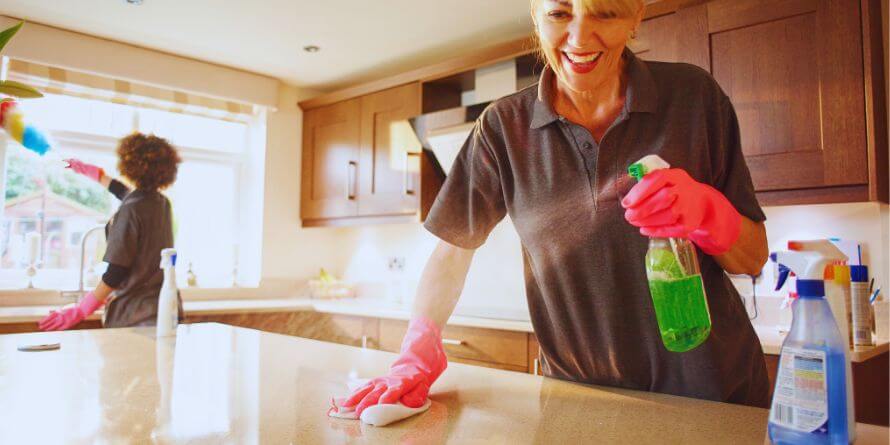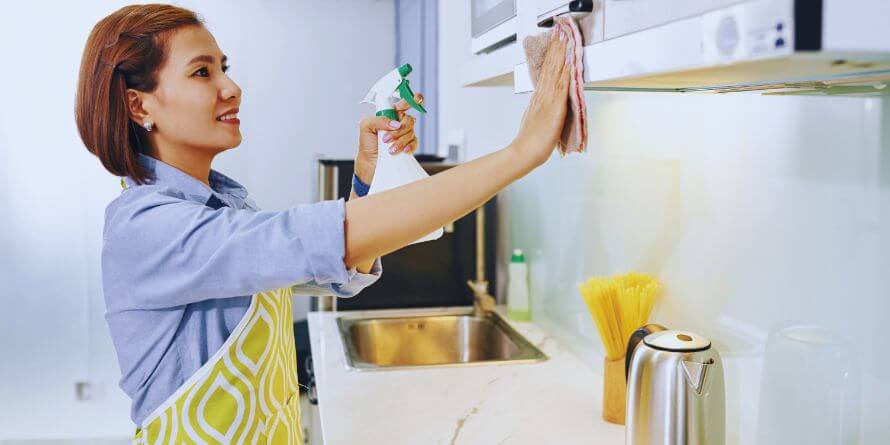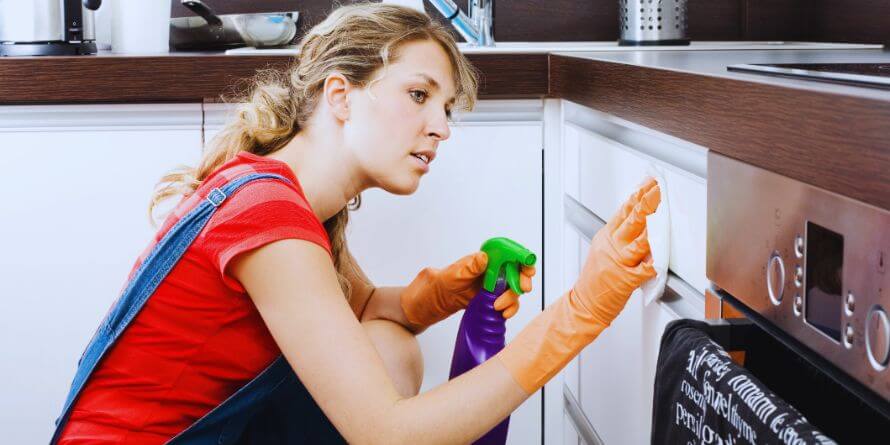The most typical questions asked by hygiene lovers are how to remove grease from kitchen cabinets and the best way to clean greasy kitchen cabinets. Your kitchen is the beauty stone of your home.
A clean and hygienic kitchen leads to a healthy family, but you need to know what is the best cleaner for greasy kitchen cabinets. A clean kitchen offers a refreshing environment and good mental health.
It also boosts your home’s aesthetics, increasing its value in beauty and cleanliness. So, to get the utmost results, you must keep your kitchen tidy and clean.
If you don’t do a regular cleaning, you will get piled-up grease, debris, dust, and even rust on kitchen countertops and cabinets. They destroy the finishing, loosen the charm, degrade the material, tarnish the appeal, and decrease the value of your kitchen.
This experience might be very frustrating for homeowners. So, how do you get rid of it? Well, it’s quite simple and easy, but consistency, along with a passion for the task, are the keys to achieving your desired cleanliness goals.
But for effective cleaning, first of all, we have to understand why our kitchen gets this greasy buildup. It’s all because of oil particles released when we fry different food substances in our kitchen.
These particles evaporate and ultimately stick to the kitchen cabinets. Over time, they give an ugly and unsightly look. The once-shiny cabinets are dull and grimy, deterring viewers because of their repellence.
Besides being less inviting, your greasy cabinets also contain a lot of germs, bacteria, and pathogens, leading to serious health risks for your family.
What Is The Best Cleaner For Greasy Kitchen Cabinets?
Sticky oil residues attract dirt and debris, creating an alarming pile-up harboring germs. Now, let’s explore how to easily clean grease off cabinets and what the most effective method is.
Should we use a DIY solution or buy a trusted chemical formula? If we are purchasing a formula, what should we look for, and what factors should we consider?
Let’s navigate the nitty-gritty of how to remove grease from kitchen cabinets to make an informed and wise decision to clean greasy cabinets and save our kitchen from germs and our family from diseases.

Common Causes of Stubborn Grease Accumulation
We can’t dispose of that frustrating grease accumulation without adequately understanding the root causes. The primary factor contributing to this accumulation is the evaporation of cooking oil and fat, which stick to the different kitchen surfaces and cabinets and attract debris.
Like when we boil different things at high heat during the cooking process, a large amount of steam and vapors are released into the kitchen. These vapors get condensed and cooled, stick to the kitchen cabinets, and build pile-ups over time.
Additionally, such accumulations may also result from different kitchen spills, such as sauces, liquids, and soups. These spills should be cleaned immediately before they dry and harden. Otherwise, they contribute to grease buildups.
Another major reason is infrequent kitchen cleaning. It’s a rule of thumb that if you clean your kitchen regularly, you will never have to spare a lot of time to clean it weekly or annually.
So, allocate some time daily to keep your kitchen shining and bright. Remember that the longer grease stays on your kitchen cabinets, the harder it is to remove it. You will have permanent spots on the cabinet material even if you remove it.
How to Clean Kitchen Ventilation Hood?
High humidity levels in the kitchen are another nuisance that leads to grease buildup. So, how do you clean the kitchen ventilation hood? Well, do everything necessary to keep your kitchen’s ventilation system functional and running smoothly all the time.
Also, avoid touching the cabinets with greasy hands, and ensure you wash your hands before touching them. Another and most important reason is the aging cabinets.
The old material loses its finish and tends to get grease pile-ups because of its rough surfaces. Ensure frequent replacement and polishing of the cabinets to avoid these buildups and sustain the kitchen’s beauty.

Why Do Conventional Cleaning Methods Often Fall Short?
Conventional kitchen cleaning methods fail for multiple reasons, but the top two are ineffective ingredients and insufficient cleaning power. These ingredients are the best solution for general cleaning, but lack the properties for effective target cleaning.
They can’t break the fats and grease, nor dissolve them; they just spread them around the corner. So, they can’t remove the grease permanently; they make it more sticky to attract more debris and build up piles.
They can’t penetrate hardened grease and uplift it. They are the best option only if you are doing a superficial cleaning, not a deep cleaning.
Conventional greasy kitchen cabinet cleaners also lack effective cleaning techniques. They use damp clothes that lead to further spread of the grease. Similarly, excessively abrasive sponges cause surface damage and tarnish the finish.
Modern cleaning methods are more focused on targeted sprays and accessories for every type of cleaning. These sprays contain only those chemicals that are highly effective for the breakdown of respective debris, dirt, and grease elements.
Conventional cleaning kitchen cabinets grease methods also lack targeted cleaning in terms of area. For example, they can’t offer a solution for cleaning cabinet corners and hard-to-reach areas.
They also often contain material that is not eco-friendly at all. They are also prone to high heat and high cold.

How To Choose the Right Cleaner?
When choosing the right cleaner for your cabinet, it’s crucial to understand the cleaner ingredients, their effectiveness, and the cabinet material.
Cleaner Ingredients
Surfactants are the primary ingredient most cleaners contain. Surfactants have a high capacity to break down grease molecules and then remove them permanently. Similarly, solvents, including ethanol and isopropanol, are vital to any grease cleaner.
They can penetrate deeply and uplift the grease. But the user should use them cautiously. Keep the area well-ventilated to prevent any health effects from those strong fumes.
Another ingredient you may find in grease remover for cabinets is alkaline agents. They work by saponifying fats. This process involves the breakdown of fats and converting them into soap and a byproduct named glycerine.
This soap and glycerine can be easily flushed out without leaving any spots behind. Similarly, there are a variety of enzyme-based cleaners on the market. These enzymes catalyze the fat breakdown process and turn that piled-up grease into easily washable.
Most importantly, they are biodegradable and eco-friendly, preventing health hazards and providing environmental safety. Some chelating agents, like EDTA, are the best option when cleaning with hard water.
They bind with hard water minerals and prevent them from reuniting, making the cleaning process smooth and easy. You will also find some ingredients listed on the product ingredient label that do not contribute to the cleaning but add fragrance and dyes.
You can choose the fragrance and dye according to your taste, but choose fragrance-free cleaning solutions if you have any allergies.
Cabinet Material
Now that you know about different cleaning ingredients, you must understand the best ingredients for various cabinet materials. This will help you avoid damaging kitchen cabinet surfaces while enhancing the cleaning effectiveness.
- If you have wood cabinets, use mild detergents, such as pH-neutral and customized solutions, and avoid harsh chemicals. This will save the cabinet material and finish.
- You can use alkaline and solvent-containing solutions for laminate cabinets, but avoid using abrasive sponges and other materials to avoid scratching the laminate surface.
- Moreover, mild detergents and non-abrasive sponges are the best options when painting cabinets. Remember that alcohol solutions will dissolve the paint, so avoid using them.
- If you have metal cabinets, avoid using acidic cleaners. Instead, prefer solutions containing surfactants and solvents, which will help you eliminate the grease without damaging the metal surface and causing rust.
- Additionally, ammonia and vinegar-like solvents are ideal for use with glass cabinets. They keep the finishing streak-free and ensure that the glass does not lose its shine.
The Best Degreaser for Kitchen Cabinets to Use Multipurpose
Explore how to remove grease from kitchen cabinets, critical techniques for effective cleaning and frequency, and the best detergents to use. Let’s read the strong degreaser for kitchen cabinets, which is the best product to remove grease from kitchen cabinets.
Here are the best grease remover for kitchen cabinets and how to use the product to remove cooking grease from cabinets.

1. Rejuvenate Cabinet And Furniture Cleaner
Powerful Cleaning Formula
The main ingredients of rejuvenate cleaner are water, Ethylene Glycol, Diethylene Glycol, Monoethyl Ether, and Acrylic Polymer; all have their specific role in making the product the first choice for cleaning various finishes.
A combination of natural oils and UV protection protects wooden items from fading and breaking down hard stains without damaging the natural formation of surfaces.
Versatile Applications
Rejuvenate is widely used to clean kitchen cabinets and furniture because its balanced pH and residue-free characteristics help to remove old oil stains, dirt, and grease.
Users can easily apply it to laminate, Formica, wood, painted kitchens, and home interiors. It makes kitchens safe for everyday use and cleans persistent stains without any long-term effort.
Effective Grease and Grime Removal
The blend of surfactants helps to remove grime and grease from multiple surfaces, such as kitchen cabinets, furniture, doors, and panels.
Rejuvenate’s application is suitable for removing fats and saturated oils from kitchen cabinets and wooden shelves. Its water-based and non-abrasive formula makes the product harm-free on wooden surfaces.
Pros
- Cost-effective price
- Premium cleaning with easy-to-apply packing
Gently remove the greasy stains and develop a protective layer on wooden surfaces to be safe from UV sun rays. - Regular use provides little to no residue finishes.
Cons
- Some customers complain about its water content and sticky texture.
- Mold content can also create discoloration when used for a long time.
2. Lysol Pro Kitchen Spray Cleaner and Degreaser
Ingredients and Antibacterial Properties
This kitchen cabinet cleaner degreaser’s core ingredients are Alkyl dimethyl benzyl ammonium chloride, Water, Phenoxyisopropanol, Lauromol Oxide, Ethanolamine, Benzoyl Salicylate, Decanal, Ethyl 2-methyl butyrate, Ethylene Brassylate, gamma-decalactone, L-menthol, Methylbenzyl Acetate, Propylene Glycol, Acetate, and Tetrahydrolinalool.
Versatile Cleaning Capabilities
Lysol is highly beneficial for removing long-term greasy stains, such as oil and spice splatters on countertops and stovetops. Baked-on stains and tough grime on kitchen appliances can also be removed by this antibacterial product.
It helps to make a sparkling kitchen with no germs and dirt while maintaining a mild fragrance that makes the cleaning experience joyful.
Easy Application
This all-purpose cleaner is straightforward, with a spray bottle, making application easy on target surfaces. The nozzle is adjustable according to the desired pattern, and users can use it by turning it clockwise.
Its cleaning process does not require rinsing or water cleaning; after spraying, the spoiled area should be wiped with a clean cloth.
Its application and cleaning method save time by providing the required results in seconds. It is the best because this degreaser spray for kitchen cabinets would smooth your cleaning journey.
Pros
- Has a pleasant smell and cleanses grease buildup and grime quickly.
- Packing is safe from leaking, and the spray nozzle has an adjustment feature for easy application.
- Antibacterial properties give additional health benefits while enhancing the kitchen’s look.
Cons
- It requires proper ventilation and safety measures for safe use.
- The smell is too strong, which can be disliked by some clients.
- Proper cleaning is needed after spraying because insufficient wiping can result in streaks on shiny surfaces.
3. ATTITUDE Kitchen Cleaner, EWG Verified
The main ingredients of this kitchen cleaner are non-ionic surfactants (caprylyl glucoside, myristyl glucoside, lauryl glucoside), Aqua, Water, Propanediol, Sodium Carbonate, Sodium Gluconate, Citric Acid, Sodium Hydroxide, Terpineol, Tetrahydrolinalool, and Triethyl Citrate.
EWG Certification and Eco-Friendly Composition
The most prominent feature of Attitude Kitchen Cleaners is its EWG certification, which builds customers’ trust and ensures its compliance with health and safety guidelines.
Its primary formation is made from plants and minerals; recyclable packaging helps maintain environmental sustainability. It is best to remove grime from kitchen cabinets.
Cleaning Capabilities
The solution is used for daily kitchen cleaning, gently removing all messes without damaging the countertop or wooden surfaces. Its natural ingredients can clean light to moderate stains excellently, but years-long grime and grease can take much effort.
The product is good at compatibility with different kitchen surfaces, including stovetops, countertops, kitchen floors, and the coatings of home appliances.
Packaging and Application
The packing bottle is recyclable and can be refilled for multiple uses. This solution is free from abrasive chemicals, so its mild composition needs additional time to stay on stains before wiping the liquid with a damp cloth.
Attitude Cleaner’s vegan formation allows it to be used on all culinary surfaces without risks. It will give you a great experience when you are cleaning it is the best grease cleaner for kitchen cabinets.
Pros
- Biodegradable and cruelty-free
- Gives clean kitchen surfaces by removing oil and dust stains
- Cost-effective with recyclable packaging
- Easy to use and approved by EWG
- Aesthetic scent and less impact on the environment
Cons
- Less effective on tough grease
- Price can be higher due to eco-friendly characteristics.
4. Easy Off Heavy Duty Degreaser Cleaner Spray
Powerful Ingredients for Tough Cleaning
This product is for those who find insufficient natural and mild solutions to make their kitchen shiny and pollution-free. The degreasers for kitchen cabinets in Easy-Off Cleaner include Water, Phenoxyisopropanol, Sodium Hydroxide, lauramine oxide, Fragrance, and Ethanolamine.
Its ingredients are specifically selected to remove the toughest grease, and these strong chemicals are inappropriate for each surface; hence, users must finalize the selection according to surface formation.
Suitable Surfaces and Cleaning Capabilities
This solution cannot be used to clean the aluminum surface, but can be applied to stovetops, wooden kitchen cabinets, sinks, and kitchen appliances. Also its a strong degreaser for kitchen cabinets.
Moreover, by using this product and rinsing it thoroughly, the complex and non-porous exterior can also become attractive and clean. Deep cleaning tasks on baked-on ovens, grills, and greasy buildup give the best results with an Easy-Off solution.
The tough stains are removed with less scrubbing, saving individual time for other household responsibilities. It is considered the best cleaner degreaser for kitchen cabinets.
Application Method and Safety Precautions
The method is relatively easy and effective, but requires some basic safety measures to avoid direct contact with the eyes or nose. The packing has one nozzle that helps to spread evenly on targeted surfaces.
After applying the product, it requires 5-6 minutes to penetrate in grime and grease and remove it from the surface. The area should be rinsed thoroughly to remove all chemicals in sensitive and culinary settings. So, this is also the best wood cabinet cleaner degreaser.
Pros
- The quick-action formula removes hard stains in a short time.
- It is beneficial to remove challenging grime and grease.
- Compatible with multiple kitchen and outdoor surfaces
Cons
- Harsh chemicals’ smell can disturb the customers
- Requires special handling and ventilation for a healthy environment.
5. Method All-Purpose Cleaner Spray, Lime + Sea Salt
Safe and Eco-Friendly Ingredients
This product is safe for pets and children because its natural ingredients have no harsh chemicals to show potential risks. what is the best cleaner for greasy kitchen cabinets? I think this product is best for your desire. This product will be the best option to clean your kitchen.
Its main ingredients are entirely eco-friendly and biodegradable to maintain environmental sustainability.
The plant and mineral-based ingredients in all-purpose cleaners include Water, Decyl Glucoside, Laureth-7 (Ethoxylated Coconut Oil), Citric Acid, Fragrance, Denotes Plant Or Mineral Origin., Sodium Carbonate, and Sodium Gluconate.
Design and Formulation
The product can transform cleaning into a pleasant task. It was designed according to the latest market trends and customers’ concerns about cleaning solutions.
The cruelty-free formulation has been tested by humans, and a natural fragrance has been added while excluding all parabens. Its name indicates that a single product can be used for various surface cleaning, such as kitchen countertops, floor tile, wood, glass, and stone surfaces.
Cleaning Capabilities
It is used in everyday cleaning tasks to remove grease and food residue. Its mild and natural ingredients may cause trouble in cleaning hard grease and grime from kitchen surfaces; users can get effective results by adding a scrubbing step in the cleaning process.
The liquid is effective for non-porous surfaces and removes stains easily. The bottle’s spray mechanism allows easy application to target places and takes a short time to penetrate grime.
Pros
- Natural ingredients make the product eco-friendly and safe for home cleaning.
- Adequate cleaning power with a pleasant sea salt smell.
- Compatible with multiple surfaces
Cons
- Bottle quality is not satisfactory
- There is a risk during shipment, or it can be damaged by falling.
6. PARKER & BAILEY Granite & Stone Cleaner
Unscented Formula for Streak-Free Cleaning
This liquid is effective for those with scent issues because its unscented nature gives streak-free finishing in one application. Parker & Bailey is the creation of Bailey, who generated the idea of granite and stone cleaner from his furniture and cabinet polish.
Its formula is specially prepared to protect granite and stone surfaces. Its application in daily cleaning gives a streak-free and shiny floor by removing all residue.
Non-Toxic Ingredients for Safe Cleaning
All added ingredients are non-toxic, so customers can freely apply the product in culinary areas and kitchen countertops. Moreover, the natural formation is free from ammonia and other harsh chemicals to protect against stone and graphite damage.
Parker and Bailey efficiently tackle cleaning problems, including removing dirt and cooking oil stains from countertops without damaging the stone.
It can also easily remove food spills, mineral buildup, water spots, and small particles from the floor and kitchen countertops, making it suitable for cleaning the food preparation areas.
User-Friendly Application
The product is manufactured with all user-friendly features. The bottle has a spray nozzle that allows the solution to be applied evenly to the targeted area.
After a few seconds, it should be cleaned with a paper towel or soft cloth because the liquid’s gentle composition requires no rinsing.
The product does not have any specific scent, and it gives a clean surface with no residue. However, customers may face minor residue in the most challenging cleaning tasks.
Pros
- It gives a smooth finish without leaving a smell
- Its ingredients are completely safe to apply around food items.
- Gentle on hands and protective for environmental sustainability
Cons
- Not effective in heavy-duty stains
- It’s designed explicitly for graphite and stone surfaces, so compatibility with other materials is low.
Time-Saving Techniques for Busy Households
Busy homeowners can adapt wipe-down cleaning methods daily and deep cleaning strategies monthly. By doing so, their kitchens will never get dirty, and they will feel mentally calm and satisfied, ditching the fear of guests’ sudden arrival.

First, let’s explore those daily wipe-down methods.
The first method is the 6/10 cleaning method, which means spending at least 10 minutes every day on 6 high-priority cleaning tasks and trying to choose those high-focus areas first.
It will help you keep your home clean every time in the long run. The second method is morning and evening cleaning routines. Spend at least 15 minutes every morning and evening on high-priority areas.
Cleaning your washrooms, making beds, and washing dishes should be a priority in the morning. In contrast, cleaning kitchen countertops, graveyards, bedrooms, and dining rooms can be done in the evening.
Similarly, you can also perform multi-surface cleaning and spot cleaning. These don’t require a lot of time, but they prevent surface pile-ups and save you time, eliminating the need for deep cleaning on a weekly or monthly basis.
Now, let’s explore deep-cleaning methods.
The most prevailing deep cleaning method for entire homes, especially cleaning grease from cabinets, is divide and clean. This means first dividing the whole cleaning process into chunks that can easily be managed.
Later, complete these tasks one after another. This approach will help you in two ways: it will prevent burnout and ensure a thorough and detailed cleaning of each area.
Besides this method, you can also clean the batch, create batches, and group similar tasks together. You can complete each batch task in one day, which will help you get a fresh and clean home without overwhelming yourself with stress.
While doing deep cleaning, keep in mind that the tool’s effectiveness matters a lot, so choose them wisely. Consider high-quality tools with long-lasting materials at reasonable costs.
Make sure to buy the tools only from those stores that have the latest variety because the latest is your tool, and the more time it will save.
Focus on decluttering first. The more efficiently you do decluttering, the more time you can save. It’s as simple as that. It will help you dispose of unnecessary items and keep the randomly placed items in the right place.
Ensure that you set a timer before you start cleaning each part. Similarly, you can also enlist help prioritizing your family members, friends, and then professionals.
FAQs
How Do You Remove Greasy Residue from Kitchen Cabinets?
You can use multiple DIY solutions to remove greasy residues from kitchen cabinets. Some of the top DIY solutions include dish soap with water, vinegar solution, and baking soda paste/solution.
You can also use commercial degreasers to quickly degrade stubborn grease pile-ups.
How Do You Remove Icky Sticky Greasy Gunk from Kitchen Cabinets?
A Homemade Gunk remover, a mixture of baking soda and vegetable oil, is the best solution for removing icky, sticky, greasy gunk. You can also make a solution using equal amounts of vinegar and baking soda with a bit of water.
What is the Best Product to Degrease Kitchen Cabinets?
The best products to effectively degrease kitchen cabinets are those containing biodegradable and nontoxic ingredients while having the utmost cleaning properties.
Every product that contains such ingredients is good to go with, as they are not hazardous for health and do not pose any environmental issues.
How Do You Clean Kitchen Cabinets Without Removing the Finish?
To remove kitchen cabinet dust, grease, and debris without affecting their finishing, you should use soft sponges and mild detergents, and mainly focus on chemical-free products.
Also, avoid scratching the surfaces or hitting them with heavy-temperature instruments.
Final Analysis
That’s all about “what is the best cleaner for greasy kitchen cabinets.” Keep in mind that effective decluttering can save half of your cleaning time. Do it manually but frequently. Use some high-quality cabinet degreasers.
Guide your children in the importance of kitchen and home cleaning, and teach them how to keep the right things in the right place. So, not now, whereas you can be cleaning old greasy kitchen cabinets.
This will make you stress-free as dividing the responsibilities among family members reduces the cleaning pressure. Join your hands, put in individual efforts, and keep your whole house neat and clean every day, every time, and every second.

